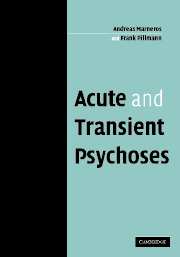Book contents
- Frontmatter
- Contents
- Preface
- Acknowledgements
- Part I History and concepts
- Part II Studies and findings
- 3 Studies on brief and acute psychoses
- 4 Frequency and sociobiographic characteristics of acute and transient psychotic disorders (ATPD) and brief psychoses (BP)
- 5 The clinical features of the acute episode
- 6 Treatment
- 7 The longitudinal course
- 8 The long-term outcome
- 9 Suicidal behaviour
- 10 Comorbidity and somatic findings
- Part III Issues of nosology
- References
- Index
5 - The clinical features of the acute episode
from Part II - Studies and findings
Published online by Cambridge University Press: 07 August 2009
- Frontmatter
- Contents
- Preface
- Acknowledgements
- Part I History and concepts
- Part II Studies and findings
- 3 Studies on brief and acute psychoses
- 4 Frequency and sociobiographic characteristics of acute and transient psychotic disorders (ATPD) and brief psychoses (BP)
- 5 The clinical features of the acute episode
- 6 Treatment
- 7 The longitudinal course
- 8 The long-term outcome
- 9 Suicidal behaviour
- 10 Comorbidity and somatic findings
- Part III Issues of nosology
- References
- Index
Summary
Precipitating factors
The question of whether an increased rate of stressful events can be found preceding the onset of ATPD is of high theoretical interest. As was discussed on page 29ff, the concepts of ‘reactive’, ‘psychogenic’ and ‘emotional’ psychoses have influenced the formation of the category of ‘ATPD’. According to these concepts, stressful events would be expected to play an important role in the pathogenesis of ATPD. There is no agreement, however, on this issue. Other concepts, including that of cycloid psychoses, do not postulate a special role for preceding stress. The authors of ICD-10 left the issue open – they did not include preceding stress as an obligatory diagnostic criterion (as DSM-III-R did in the category of Brief Reactive Psychosis), but they provided an option to code ‘associated acute stress’ as present or absent.
The ICD-10 specifier ‘associated acute stress’ must be regarded as ‘narrowly defined’ for two reasons. First, it requires a close temporal relationship (2 weeks) with the event and the onset of psychosis; and second, it requires that the event be particularly stressful in nature. In contrast, there is a long tradition of life-event research in psychotic and affective disorders which has shown that there may be elevated rates of a broad range of adverse events in a period of several months before the onset of a major affective episode or the onset of a psychotic episode (Paykel, 1990, 1994; Marneros, 1999; Mundt et al., 2000).
- Type
- Chapter
- Information
- Acute and Transient Psychoses , pp. 103 - 119Publisher: Cambridge University PressPrint publication year: 2004



